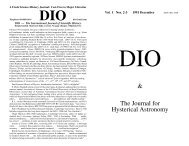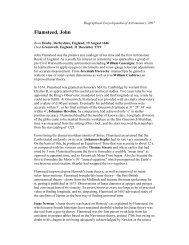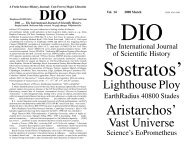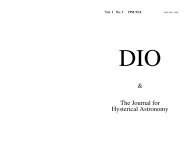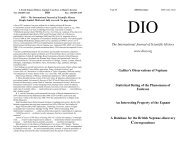DIO 1.2 - DIO, The International Journal of Scientific History
DIO 1.2 - DIO, The International Journal of Scientific History
DIO 1.2 - DIO, The International Journal of Scientific History
Create successful ePaper yourself
Turn your PDF publications into a flip-book with our unique Google optimized e-Paper software.
152 1991 December <strong>DIO</strong> 1.3 ‡9<br />
N7 Suppose the 2 peculiarities noted at §N5 are related. Realization <strong>of</strong> the implications<br />
<strong>of</strong> overdetermination here suggests a simple hypothesis which solves both oddities<br />
simultaneously: Hipparchos did not use the full trio to solve for 3 elements; instead, he<br />
merely, in each case (trio A & trio B), used one interval (between one pair <strong>of</strong> eclipses) to<br />
solve for one element: e for trio A and r for trio B. <strong>The</strong> full 3-unknown calculation for<br />
a trio is extremely laborious (see Almajest 4.6-8 or, e.g., Toomer 1973 or Pedersen 1974<br />
pp.172f), so Hipparchos took a shortcut, which we will now examine. (If this ploy was that<br />
<strong>of</strong> hirelings, did Hipparchos even know <strong>of</strong> it? See fn 253.) For reconstructing his shortcut,<br />
we assume that he used the intervals A3-A2 and B2-B1. <strong>The</strong> four retained eclipses 223 —<br />
A2, A3, B1, B2 —- will (§N10 & eq. 9) prove to be consistent with the same value <strong>of</strong> A<br />
(or g ◦). Moreover, this value is integral; such rounded parameters are typical <strong>of</strong> antiquity.<br />
(See Rawlins 1985K, which long predated the current findings, and whose speculations<br />
are now being confirmed here by repeated neat success: §K10, fn 196, §N4, §N7.) Our<br />
reconstruction will culminate swiftly & beautifully below, at §N14.<br />
N8 Pedersen 1974 says (p.174 n.5) that O.Neugebauer suggested (as does Toomer 1973<br />
p.8) Hipparchos as inventor <strong>of</strong> the eclipse trio method <strong>of</strong> Almajest 4.6. <strong>The</strong> results <strong>of</strong><br />
the current paper show otherwise — and leave us with no direct evidence <strong>of</strong> the method’s<br />
use before Ptolemy. (Same for equation <strong>of</strong> time: Jones 1991H n.25. Ptolemy’s math at<br />
Almajest 4.6 is far superior to what we are here revealing to be behind the Hipparchan work<br />
preserved at Almajest 4.11.) Comments: [a] <strong>The</strong>re is no evidence that Ptolemy originated it<br />
(though he seems admirably adept at it). In fact, Hipparchos’ mention <strong>of</strong> trios in both cases<br />
A&B suggests that the triad technique (Almajest 4.6) predates him (thus his pretense to<br />
being up to the mathematician-standards <strong>of</strong> his day). [b] <strong>The</strong> triad method involves lovely<br />
math but is impractical because highly sensitive to small observational errors (fn 218 &<br />
§P1). [c] <strong>The</strong> actual ancient determiner <strong>of</strong> the Almajest lunar elements was much more<br />
likely 224 to have accomplished his purpose by examining fits <strong>of</strong> dozens <strong>of</strong> eclipses.<br />
223 [Revised 1997.] <strong>The</strong> unreduced reports (seasonal hours, apparent time) <strong>of</strong> the trio B eclipses (Alexandria) are<br />
creditably accurate; trio A (observed at Babylon, but dated by Athenian calendar), curiously poor. (<strong>The</strong> eye can<br />
discern a total eclipse’s mid-time to ordmag 1 timemin; so the main sources <strong>of</strong> ancient eclipse times’ errors may<br />
be: [a] lunar hr-angle via sundial for time, & [b] reporters’ roundings.) Comparing to modern calculations, we find<br />
equinoctial-time O−C errors for each observed eclipse bound: −46 m (A1), −40 m (A2), +10 m (A3), −7 m (B1),<br />
+10 m (B2), −10 m (B3). (Trio A rms error = 0h.6; trio B, merely 0h.2. So, I do not agree with R.Newton 1977 pp.122f<br />
& 345 that the trio B raw observational data were fabricated.) Note, at Almajest 4.11: most trio A eclipse-times are<br />
given in whole hrs; trio B, thirds <strong>of</strong> hrs. (Halving these figures produces roughly the above-cited rms errors — which<br />
should be the case if the data are genuine.) This presumably reflects the (real) greater precision-needs <strong>of</strong> 200 BC<br />
Greek theorists vs. 382 BC Babylonian theorists. And Greek borrowing <strong>of</strong> the trio A Babylon observations hints<br />
that 382 BC Greek astronomical observers were inferior to Babylon’s. Ptolemy’s fudged reductions (to Alexandria<br />
mean time <strong>of</strong> mid-eclipse) infected the data with serious additional errors: +11 m (A1), +24 m (A2), −13 m (A3),<br />
−6 m (B1), +22 m (B2), −21 m (B3). Thus, Ptol−C errors <strong>of</strong> his Almajest 4.11 intervals: +20 m (A2−A1), +12 m<br />
(A3−A2), +45 m (B2−B1), −63 m (B3−B2). Ptolemy’s lunar A and r were well chosen, but his acceptance <strong>of</strong><br />
the Hipparchos PH lunisolar theory introduced a large annual periodic error (amplitude c.20 m after accounting for<br />
then-unknown lunar theory annual equation): effect much worse for trio B (Mar-Sep) than for trio A (Jun-Dec). Thus,<br />
his intervals’ errors (above) had to be larger for trio B than for trio A. Such conveniently scaled errors are typical<br />
<strong>of</strong> “<strong>The</strong> Greatest Astronomer <strong>of</strong> Antiquity”. I believe that the first clear enunciation <strong>of</strong> this crucial point (in another<br />
Almajest context) is due to Gingerich 1980 p.262 & Fig.3. (Ptolemy was fudging towards a theory that happened to<br />
give nearly correct times for trio A; but for trio B, where his theory happened to be very wrong, the same habit led<br />
to disaster. I.e., his improvement <strong>of</strong> trio A times’ accuracy doesn’t undo RN’s correct conclusion that both trios are<br />
fudged.) Bottom lines: [a] Ptolemy pretended that his theories fit outdoor eclipses to ordmag a timemin, though his<br />
adopted trio B eclipse time-intervals were <strong>of</strong>f by ordmag an hour. [b] Trio B’s 3 observed times were (rms) thrice as<br />
accurate as trio A’s; but, after <strong>The</strong>-Greatest’s massages, trio B’s 2 intervals were (rms) thrice as inaccurate as trio A’s.<br />
224 This elementary point was never understood by Ptolemy, nor is it grasped by most modern commentators on<br />
him — few <strong>of</strong> whom have experience at fitting orbits to data (a point which needs no further defense after the current<br />
paper’s revelations). An exception is Muffia-friend P.Huber (1991/10/1 to <strong>DIO</strong>, quoted more fully at <strong>DIO</strong> 2.1 ‡2<br />
§H22): “I am pretty sure that the ancient astronomers . . . must have derived their parameters by trial and error from<br />
rather inadequate sets <strong>of</strong> observations.” Compare to DR’s comments (1986/2/28 to van der Waerden): “A . . . general<br />
thought about our remnants <strong>of</strong> ancient astronomy. Real evolution <strong>of</strong> empirical astronomical theories has nothing to do<br />
with the sort <strong>of</strong> artificial math we find in the [Almajest]. <strong>The</strong> orbit <strong>of</strong> a planet is not based on a handful <strong>of</strong> observations<br />
which are then treated by Euclidean postulates in a neat formal manner. No, ancient orbits obviously evolved like<br />
1991 December <strong>DIO</strong> 1.3 ‡9 153<br />
N9 Another note on ancient procedure: if Ptolemy’s approach (Almajest 4.2 f) is any<br />
guide, Hipparchos’ math formally used anomalistic motion (eq. 7) rather than apogee<br />
motion (fn 217). Thus, recalling that adoption <strong>of</strong> ɛ = 178 ◦ (eq. 8) produced A nearly equal<br />
to 96 ◦ (§N5), we see that the corresponding Phil 1 epoch value for mean anomaly g ◦ would<br />
have been:<br />
g ◦ = ɛ − A = 178 ◦ − 96 ◦ = 82 ◦ (9)<br />
— just as integral a parameter as input ɛ & A, <strong>of</strong> course. We will now find out if this was<br />
indeed Hipparchos’ adopted value.<br />
N10 To test the intriguing hypothesis <strong>of</strong> §N7, we need only set e or r equal to the value<br />
which Hipparchos calculated (reported at Almajest 4.11) and then work backwards to solve<br />
for g ◦. <strong>The</strong> results for g ◦ are given below, along with the input data:<br />
Reported Interval Assumed Deduced<br />
A3−A2 = 175 ◦ 07 ′ e = (327 ′ 2/3)/(3144 ′ ) g ◦ = 81 ◦ 59 ′<br />
B2−B1 = 180 ◦ 20 ′ r = (247 ′ 1/2)/(3122 ′ 1/2) g ◦ = 81 ◦ 58 ′<br />
N11 <strong>The</strong> g ◦ found here are strikingly close to each other and to the already-suspected<br />
(eq. 9) integral value, g ◦ = 82 ◦ . (<strong>The</strong> odds are ordmag 1000-to-1 that both g ◦ would hit by<br />
chance so close to the same integral value.) As just noted, the associated Aristarchos-EH<br />
ɛ = 178 ◦ (eq. 8) is also integral. So I am proposing (§N7) that Hipparchos adopted these<br />
two integral values for ɛ & g ◦ at the outset — and thus he solved only for a single unknown<br />
(e or r) from a single interval, for each eclipse trio. Since it is clear 225 that he pretended<br />
otherwise, this is a double mathematical hoax. 226 (Comment: Though I have sometimes<br />
been critical <strong>of</strong> Hipparchos — whose scientific acumen was rather overrated by later ancients<br />
— neither I nor any other scholar ever previously suspected him <strong>of</strong> any sort <strong>of</strong> dishonesty.)<br />
As noted, the single-interval math would be relatively easy. Two true longitudes form the<br />
given interval. And we could find the corresponding two mean anomalies by computing<br />
from eqs. 6, 7, & 9; however, the first step (§N12) <strong>of</strong> my reconstruction is simpler than<br />
this. That reconstruction’s ultimate success (§N14) therefore evidences, on the ancient<br />
computer’s part, a subtle feel for the problem. He understood 2 related points: [a] the<br />
anomaly-differences needed to be more accurate than the absolute anomalies; [b] after<br />
computing the 1 st eclipse’s anomaly from the epoch value (g ◦, eq. 9) and his anomaly tables<br />
(founded upon eqs. 6 & 7), the remaining required eclipses’ anomalies are most easily<br />
found differentially (much as at §L3).<br />
modern ones: through decades <strong>of</strong> incremental adjustment, in response to scrupulously observed & analyzed failures<br />
<strong>of</strong> theory. Thus, the very format <strong>of</strong> the [Almajest], which modern Ptolemists . . . worship above all, is ironically one<br />
<strong>of</strong> its most egregiously phony aspects.” (Neugebauer 1957 p.191 rates the Almajest “one <strong>of</strong> the greatest masterpieces<br />
<strong>of</strong> scientific analysis ever written”.) Jones 1991M p.445 (emph added) innocently lauds “Hipparchus’s use <strong>of</strong> small<br />
numbers <strong>of</strong> carefully selected observations to determine the parameters <strong>of</strong> his models”. Of course, no one knew just<br />
how small was the actual number <strong>of</strong> data Hipparchos used — until the present discoveries, starting at §N7. <strong>The</strong>se<br />
findings thus dramatically demonstrate (since no real astronomer would compute r from 2 data!) that Hipparchos<br />
was not at all a serious contributor to ancient astronomy’s development <strong>of</strong> the lunar theory, e.g., the excellent value <strong>of</strong><br />
r (5 p 1/4) preserved in the Almajest — which I suspect was that <strong>of</strong> Aristarchos and-or Apollonios. (Trio B occurred<br />
at the very time Apollonios flourished. But we do not possess evidence that Hipparchos used his work, while the<br />
connection <strong>of</strong> Hipparchos to Aristarchos is undeniable. See Almajest 3.1; also above at §N2.) Further: given the<br />
number <strong>of</strong> small but nontrivial then-unknown perturbations in the lunar motion, it was not possible in antiquity to<br />
mathematically elicit a highly reliable estimate <strong>of</strong> r from an eclipse triad (no matter if the 3 observations were<br />
perfectly accurate), nor could extremely consistent values be obtained even from a string <strong>of</strong> perfectly observed eclipse<br />
triads. (In Almajest 4.6 & 4.11, Ptolemy outrageously pretends that all 4 <strong>of</strong> his adduced triads are consistent, to<br />
ordmag one arcmin, with the same eq.ctr & thus r: see R.Newton 1977 pp.122-123.) An astronomer with genuine<br />
experience in such matters would have known that.<br />
225 See Almajest 4.5 & 11 and Toomer 1984 p.181 n.24.<br />
226 Some may aver that this charge evidences an overcritical nature in DR. Comment: this is a serious mathematical<br />
pretense, which misled numerous scholars (in various ways) for over 2000 y ; indeed, the most tragic victim <strong>of</strong> the<br />
imposition is a living scholar, Hipparchos’ modern biographer, G.Toomer. Thus, one is justified in plainly calling it<br />
fakery (on the part <strong>of</strong> someone in Hipparchos’ school).



